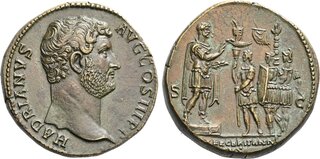| Numismatica Ars Classica > Auction 144 with CNG & NGSA | Auction date: 8 May 2024 |
| Lot number: 1064 Price realized: This lot is for sale in an upcoming auction - Bid on this lot  | Show similar lots on CoinArchives Find similar lots in upcoming auctions on |
| Lot description: The Geoffrey Cope Collection of Ancient Greek and Roman Bronzes. The Roman Empire. Hadrian augustus, 117 – 138. Description Sestertius, Roma 130-133, Æ 32 mm, 26.50 g. HADRIANVS – AVG COS III P P Bare head r. Rev. [EX]ERC BRITANNI/[CV]S Hadrian standing r. on low platform, holding scroll and raising hand; before him, three soldiers with standards. In field, S – C. Reference C 555 var. (bare head and cuirassed) BMC 1673 RIC 1918 L. D'Orazi, La collezione Numismatica di Prospero Sarti e il Mistero del Ripostiglio di Bolsena, in Quaderni di Studio XV, 2020, p. 146 (this coin illustrated) SCBC 637 (this coin illustrated) Condition Extremely rare and by far the finest of very few specimens known. An issue of tremendous fascination and historical importance with a portrait of enchanting beauty, the workof a very talented engraver, and a finely engraved reverse composition with a miniature portrait of the Emperor of great craftsmanship. Undoubtedly one of the most desirable sestertii to have survived from antiquity. Wonderful brown tone and good extremely fine Provenance Sangiorgi sale 7th May 1906, Sarti, 428 Leu sale 25, 1980, 305 Note: This coin has been on loan and on display in the British Museum for several years. The coin is published in Coin Week.Although Hadrian is only known for certain to have personally visited the province of Britannia in 122, this remarkable sestertius and other related issues suggest a second visit at some time between 130 and 137. The reverse type appears to celebrate an appearance made by Hadrian before the military forces present in Britannia since the exergue legend identifies the EXERCITVS BRITANNICVS. The scene is of the typical adlocutio type, in which the emperor is shown on a podium addressing the troops. In this particular case, the listeners are legionary standard bearers wearing their full armour. The two closest to Hadrian even wear animal skins on their heads-a means of increasing their visibility to the soldiers who followed them into battle-but it is unclear whether they are intended as lion, panther, or bear skins. All three are known to have been worn by Roman standard bearers. The standard bearer closest to Hadrian is an aquilifer, the soldier responsible for carrying the aquila, or eagle, standard of the legion while the soldier behind him is the signifer, who carries the signum standard of a Roman cohort. It is easily distinguished by its composition of ornamental disks topped by an open hand emblematic of the oath of loyalty sworn by the legionary to the emperor. Holding a transverse standard behind the signifer is the vexillarius, the soldier responsible for carrying the vexillum banner of a Roman maniple. Together the movements of these men and their standards combined with shouted orders allowed the legion and its parts to fight with great skill and overcome great enemies. As an issue of the 130s, the coin most likely depicts the emperor congratulating the men of legio II Augusta, legio VI Victrix, and legio XX Valeria Victrix for their completion of the great fortification network known as Hadrian's Wall. In 122, during Hadrian's first visit to Britannia, he had ordered the construction of the wall in order to increase the security of the province. From the initial invasions of Julius Caesar and Claudius up to the reign of Hadrian, the Roman conquest had primarily focused on the regions that are now modern England and Wales and was generally successful. With the exception of revolts by some local Celtic rulers in the mid-first century AD, by 100, England and Wales were fully connected by Roman roads and controlled by permanent military camps. However, northern England and Scotland remained an area of concern. The Caledonians of the north remained a threat that could not be easily crushed. Even the great military emperor Trajan decided to avoid becoming bogged down in an extended war with the Caledonians and fixed the northern border of Britannia between what is now Newcastle-upon-Tyne and Carlisle. Hadrian's Wall served to strengthen Trajan's border with the extended network of forts and wall as a means of preventing Caledonian incursions and of discouraging potential revolt in the northern part of the province. It took about 15,000 men six years to construct the entire fortification system over some 80 Roman miles. Although it was originally envisioned as a long stone curtain wall punctuated by gates, towers and forts in order to fully cut off the Celtic lands of the north from the Roman province of Britannia, at some point Hadrian changed his plans and the eastern 30-mile section of Hadrian's Wall was only constructed from turf. Perhaps the cost of the stone fortification was deemed excessive or it was considered a waste of military manpower that was needed elsewhere. Whatever the case, the entire system was complete by 128 and the legionaries who had worked on its construction were deserving of a rest and reward. One can almost imagine Hadrian praising the troops for a job well done before ordering the distribution of sestertii as a donative. This coin is not only spectacular for its succinct encapsulation of a specific important moment in both Roman military history and British national history, but also for its pedigree to the hallowed collection of the British Museum. Estimate: 300000 CHF |  |



